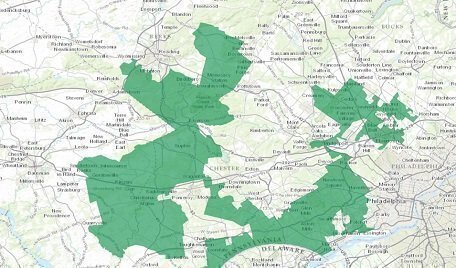Pennsylvania Governor Thomas W. Wolf told the state’s Supreme Court on Tuesday that a new Republican-drawn map of election districts for the 18-member Pennsylvania delegation in the U.S. House of Representatives does not satisfy the mandate of the state court to avoid partisan gerrymandering. Like the 2011 map that the state’s highest court struck down last month, the substitute redistricting plan drawn up by two Republican leaders of the legislature strongly favors Republican candidates, the governor argued.
 Moreover, the governor said, the new map did not come from the legislature itself, but was the work only of the GOP leaders of the two houses of the legislature, and they had not been given authority to do the legislature’s work for it.
Moreover, the governor said, the new map did not come from the legislature itself, but was the work only of the GOP leaders of the two houses of the legislature, and they had not been given authority to do the legislature’s work for it.
When the two GOP leaders sent their proposed new districting map to the state court on Friday, they argued that the court had not given the legislature enough time to do the task, so the leaders had to do what they could to obey the court’s ruling. They argued that the map would be valid under the court’s decision.
If the state court agrees with the governor’s opposition, the court itself is likely to take on the task of drafting new election boundaries. There apparently is not time enough to send the issue back to the state legislature, without seriously disrupting this year’s election calendar in Pennsylvania. As things stand today, the planned May 15 primary election may have to be delayed unless the state court is able to move very rapidly in drafting a substitute map. Even though it had given the legislature the first chance to draw a replacement plan, it has already begun work on one of its own, just in case.
The 2011 map that was nullified by the divided decision of the state court in January had been used in three past elections. The result each time was that Republicans won 13 seats and the Democrats won five, even though the statewide vote in each of those elections was close to evenly split. The state court majority ruled that the state constitution does not allow partisan factors to control the districting process, and that the 2011 plan had done just that.
The Republicans control both houses of the Pennsylvania legislature, and the GOP leaders of each house have argued that the control over redistricting of congressional seats is assigned by the U.S. Constitution to the legislature, so the state court had no authority to get involved. The GOP leaders attempted to take that issue to the U.S. Supreme Court, but that effort failed, returning the controversy to the state level.
In submitting the Republican leaders’ proposed new map to the state court, the leaders contended that the lines fully respect traditional criteria for such maps, including that the individual district lines are not drawn to odd shapes, that population equality among the districts was preserved, and that the lines divide up far fewer county, city and precinct clusters than the 2011 plan would have.
While the GOP leaders have made what they deemed a genuine effort to satisfy the state court’s decision, they also have indicated that, if the court itself draws up a new map, they will seek to challenge that outcome in federal court.
Unless a federal court steps in, however, the state court it expected to keep moving along toward developing a new map for the 18 seats, with the new district lines to control where voters are placed for this year’s May primary and November general elections.
Legendary journalist Lyle Denniston has written for us as a contributor since June 2011 and has covered the Supreme Court since 1958. His work also appears on lyldenlawnews.com.






